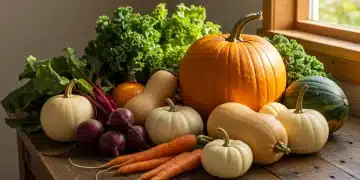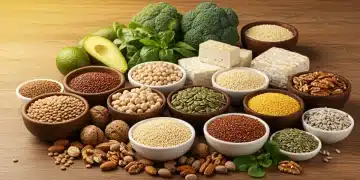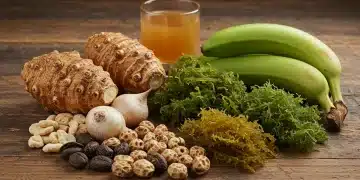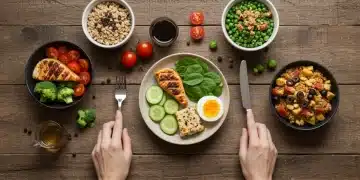Summer 2025 Seasonal Eating: Maximize Health with Fresh Produce
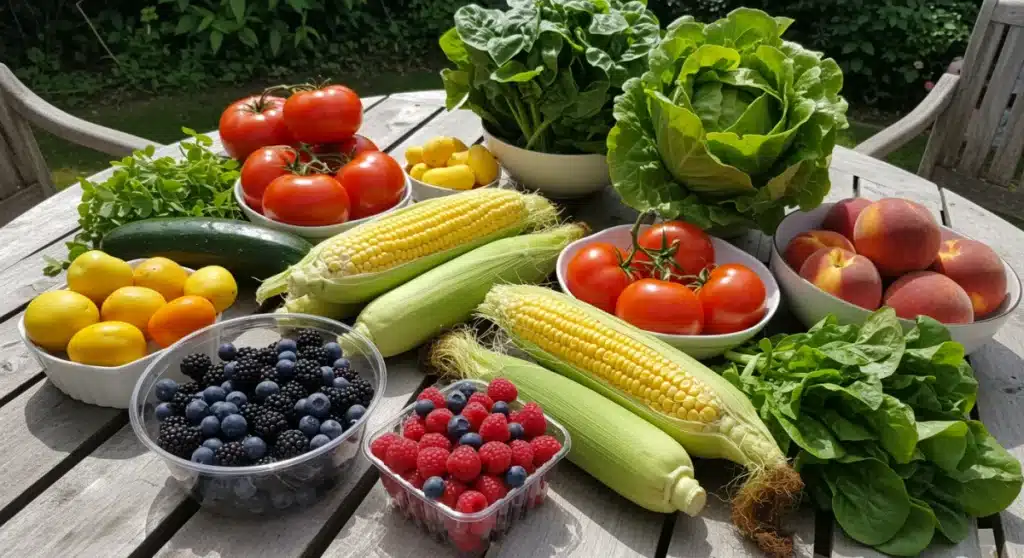
Embracing seasonal eating in Summer 2025 is crucial for maximizing health, ensuring optimal nutrient intake from fresh produce, and supporting local agriculture for a sustainable lifestyle.
As Summer 2025 approaches, the opportunity to revitalize our diets with nature’s bounty becomes paramount. Focusing on seasonal eating summer 2025 means more than just enjoying delicious flavors; it’s a strategic approach to maximizing health, supporting local economies, and reducing our environmental footprint. This guide will help you navigate the vibrant world of summer produce, ensuring you make the most of what’s fresh and available.
Understanding the Benefits of Seasonal Eating
Seasonal eating is a practice rooted in consuming fruits and vegetables at their peak ripeness and availability. This approach offers a multitude of benefits that extend beyond mere taste, impacting our health, our communities, and the planet. When produce is harvested in season, it has naturally ripened and is often picked closer to consumption, meaning it retains more of its vital nutrients.
Beyond the nutritional advantages, seasonal eating often translates to a richer, more intense flavor profile. Imagine the difference between a perfectly ripe, sun-kissed tomato picked in July versus one harvested prematurely and shipped across continents in winter. The former bursts with natural sweetness and acidity, a testament to its optimal growing conditions. This enhanced flavor can make healthy eating a more enjoyable and satisfying experience, encouraging greater consumption of fruits and vegetables.
Nutritional Superiority
Fruits and vegetables harvested in season typically contain higher levels of vitamins, minerals, and antioxidants compared to their out-of-season counterparts. This is because produce picked at its prime has had ample time to absorb nutrients from the soil and sunlight. Conversely, produce that is picked unripe and then ripened artificially, or transported long distances, can lose a significant portion of its nutritional value.
- Higher nutrient content due to natural ripening cycles.
- Reduced need for artificial preservatives or ripening agents.
- Enhanced antioxidant levels, contributing to overall health and disease prevention.
Environmental and Economic Impact
Choosing seasonal produce often means sourcing locally. This significantly reduces the carbon footprint associated with long-distance transportation, refrigeration, and packaging. Supporting local farmers also strengthens the community’s economy, helping to sustain agricultural practices and preserve open spaces. It fosters a direct connection between consumers and their food sources, promoting transparency and trust.
In summary, embracing seasonal eating allows us to enjoy food at its most nutritious and flavorful, while also making responsible choices for our environment and local economies. It’s a holistic approach to well-being that benefits all involved.
Key Summer 2025 Produce: A Bounty of Freshness
Summer 2025 promises an abundance of delicious and nutritious produce, perfect for creating refreshing meals and snacks. Knowing what’s in season can guide your shopping choices, ensuring you bring home the freshest and most flavorful ingredients. From juicy fruits to crisp vegetables, summer offers a diverse palette of options to nourish your body and delight your taste buds.
This section will highlight some of the stars of summer produce, focusing on their nutritional benefits and versatile culinary uses. Incorporating these items into your daily diet is an excellent way to boost your vitamin and mineral intake, stay hydrated, and enjoy the natural sweetness and crunch that only seasonal foods can provide.
Fruits to Savor
Summer is synonymous with an explosion of fruit flavors. Berries, stone fruits, and melons are at their peak, offering natural sweetness and a wealth of health benefits. These fruits are not only delicious on their own but also make excellent additions to desserts, salads, and smoothies.
- Berries (Strawberries, Blueberries, Raspberries): Rich in antioxidants, vitamins C and K, and fiber. Excellent for heart health and cognitive function.
- Stone Fruits (Peaches, Plums, Nectarines): Packed with vitamins A and C, potassium, and antioxidants. Great for skin health and digestion.
- Melons (Watermelon, Cantaloupe, Honeydew): High in water content, making them incredibly hydrating. Also provide vitamins A and C, and electrolytes.
Vegetables to Enjoy
Summer vegetables offer a crisp texture and earthy flavors that complement any meal. From leafy greens to root vegetables, the variety is vast, providing essential nutrients for overall well-being. These vegetables can be roasted, grilled, sautéed, or enjoyed raw in salads.
Corn on the cob, green beans, bell peppers, and zucchini are just a few examples of the vibrant vegetables that thrive in the summer months. These vegetables are versatile and can be incorporated into countless recipes, adding both flavor and nutrition. Their freshness can elevate even the simplest dishes.
In essence, the summer produce lineup is a nutrient powerhouse, offering everything your body needs to thrive in the warmer months. Make sure to visit your local farmers’ markets or grocery stores to stock up on these seasonal delights.
Maximizing Nutrient Intake with Summer Produce
Beyond simply eating seasonal produce, understanding how to best prepare and combine these ingredients can further enhance their nutritional impact. The goal is to retain as many vitamins, minerals, and antioxidants as possible, ensuring that every bite contributes optimally to your health. This involves smart cooking methods and mindful meal planning.
Different cooking techniques affect nutrient retention differently. For instance, some water-soluble vitamins, like Vitamin C and B vitamins, can be lost through excessive boiling. Conversely, certain fat-soluble vitamins, such as A, D, E, and K, are better absorbed when consumed with a small amount of healthy fats. Therefore, a balanced approach to preparation is key.
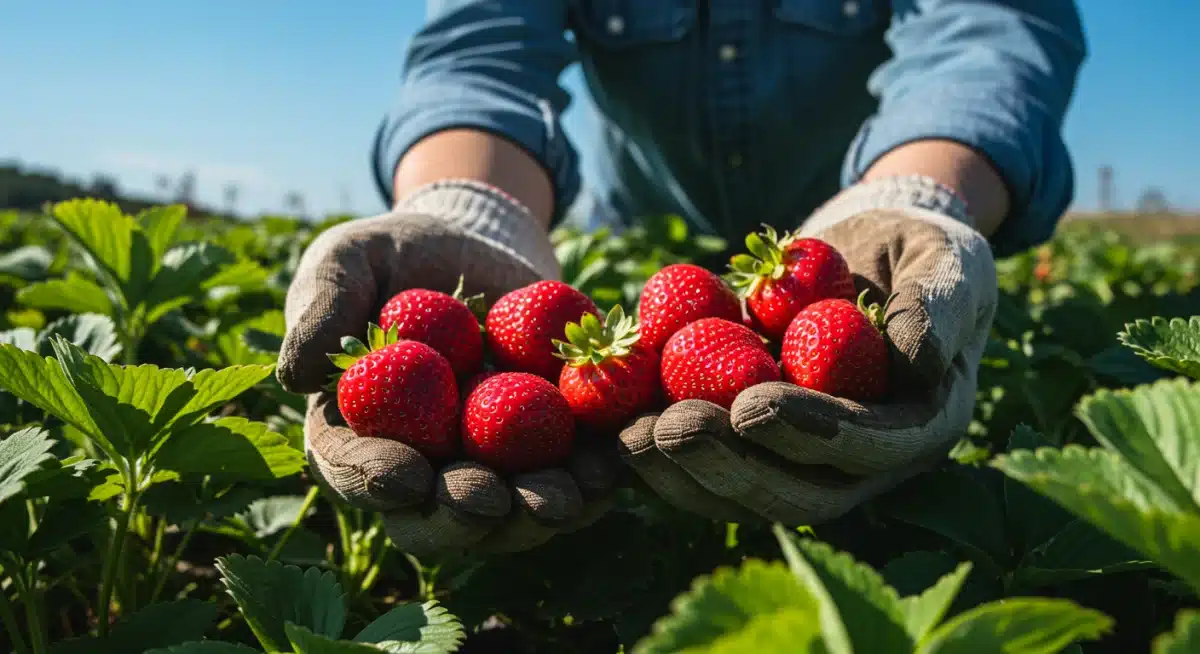
Optimal Cooking Methods
To preserve the integrity of summer vegetables, opt for cooking methods that minimize nutrient loss. Steaming, grilling, and light sautéing are excellent choices that help maintain the vibrant colors, textures, and nutritional profiles of your produce. Raw consumption, whenever appropriate, is also highly beneficial.
- Steaming: Gentle cooking that preserves most water-soluble vitamins.
- Grilling: Adds a smoky flavor and retains nutrients, especially for firmer vegetables.
- Light Sautéing: Quick cooking in minimal healthy fat, good for leafy greens and tender vegetables.
Pairing for Enhanced Absorption
Combining certain foods can create synergistic effects, where nutrients are better absorbed or utilized by the body. For example, pairing iron-rich foods with Vitamin C sources can significantly boost iron absorption. Similarly, consuming fat-soluble vitamins with healthy fats ensures their optimal uptake.
Consider adding a squeeze of fresh lemon juice (Vitamin C) to your iron-rich spinach salad. Drizzle olive oil over your grilled bell peppers and zucchini to aid in the absorption of vitamins A and E. These small adjustments can make a big difference in how your body processes and benefits from the nutrients in your seasonal meals.
By being mindful of both cooking techniques and food pairings, you can elevate your summer seasonal eating to a new level, ensuring you get the most out of every delicious and healthy ingredient.
Delicious Recipes for Summer 2025 Seasonal Eating
Embracing seasonal eating summer 2025 is not just about health; it’s also about enjoying incredible flavors. Summer produce lends itself beautifully to light, refreshing, and easy-to-prepare dishes that are perfect for warm weather. From vibrant salads to grilled delights, there are countless ways to incorporate these fresh ingredients into your daily meals.
This section will provide some inspiring recipe ideas that highlight the best of summer’s bounty. These recipes are designed to be simple yet flavorful, allowing the natural goodness of the produce to shine through. They cater to a variety of tastes and can be easily adapted to suit your preferences and dietary needs.
Refreshing Summer Salads
Salads are a quintessential summer meal, offering a perfect blend of crisp textures and juicy flavors. They are quick to assemble and can be incredibly satisfying, especially when packed with seasonal vegetables and fruits. The key is to use fresh, high-quality ingredients and a light, flavorful dressing.
- Watermelon and Feta Salad with Mint: A sweet and savory combination that is incredibly refreshing.
- Caprese Salad with Heirloom Tomatoes: Showcases the rich flavor of ripe summer tomatoes with fresh mozzarella and basil.
- Grilled Peach and Arugula Salad with Goat Cheese: A sophisticated salad that balances sweetness, bitterness, and creaminess.
Grilling and Sautéing Summer Favorites
Grilling is a popular summer cooking method that brings out the natural sweetness and char of vegetables. It’s also a healthy way to prepare meals, requiring minimal added fats. Sautéing is another quick option for tenderizing vegetables while retaining their vibrant color and nutrients.
Try grilling corn on the cob until slightly charred, or preparing skewers with bell peppers, zucchini, and cherry tomatoes. Sauté green beans with garlic and a touch of olive oil for a simple yet delicious side dish. These methods allow you to enjoy the robust flavors of summer produce without heavy preparations.
By experimenting with these recipes and cooking techniques, you can transform seasonal ingredients into truly memorable and healthy meals throughout Summer 2025. Don’t be afraid to get creative and discover new favorite combinations.
Meal Planning for Seasonal Eating Summer 2025
Effective meal planning is crucial for successfully integrating seasonal eating summer 2025 into your lifestyle. A well-thought-out plan not only ensures you utilize fresh produce before it spoils but also helps you save time, reduce food waste, and maintain a balanced diet. It transforms the often-overwhelming task of healthy eating into a manageable and enjoyable routine.
Start by identifying the seasonal produce available in your region. Farmers’ market visits are excellent for this, as vendors can often provide tips on ripeness and storage. Once you know what’s fresh, you can build your weekly menu around these ingredients, focusing on versatility and maximizing their use across different meals.
Weekly Shopping and Prep Strategies
A structured approach to grocery shopping and meal preparation can make seasonal eating much easier. Dedicate a specific day each week for shopping and another for initial food prep. This ensures you have fresh ingredients on hand and cuts down on cooking time during busy weekdays.
- Farmers’ Market First: Prioritize visiting local farmers’ markets to discover the freshest seasonal offerings.
- Batch Cooking Basics: Prepare staple ingredients like grilled chicken or roasted vegetables in larger quantities to use in multiple meals.
- Pre-chopping Produce: Wash, chop, and store vegetables like bell peppers, carrots, and celery so they are ready for quick snacks or meal additions.
Sample Summer Weekly Meal Plan
Creating a flexible meal plan can help ensure you consistently incorporate seasonal produce. Here’s a basic framework that can be adapted to your preferences, focusing on variety and nutrient density.
For breakfast, consider berry smoothies or oatmeal topped with fresh peaches. Lunch could involve a large salad featuring grilled chicken and a medley of summer greens, cucumbers, and tomatoes. Dinners can range from grilled fish with a side of sautéed zucchini and corn to vegetarian chili packed with beans and summer squash. Snacks might include sliced melon or a handful of fresh berries.
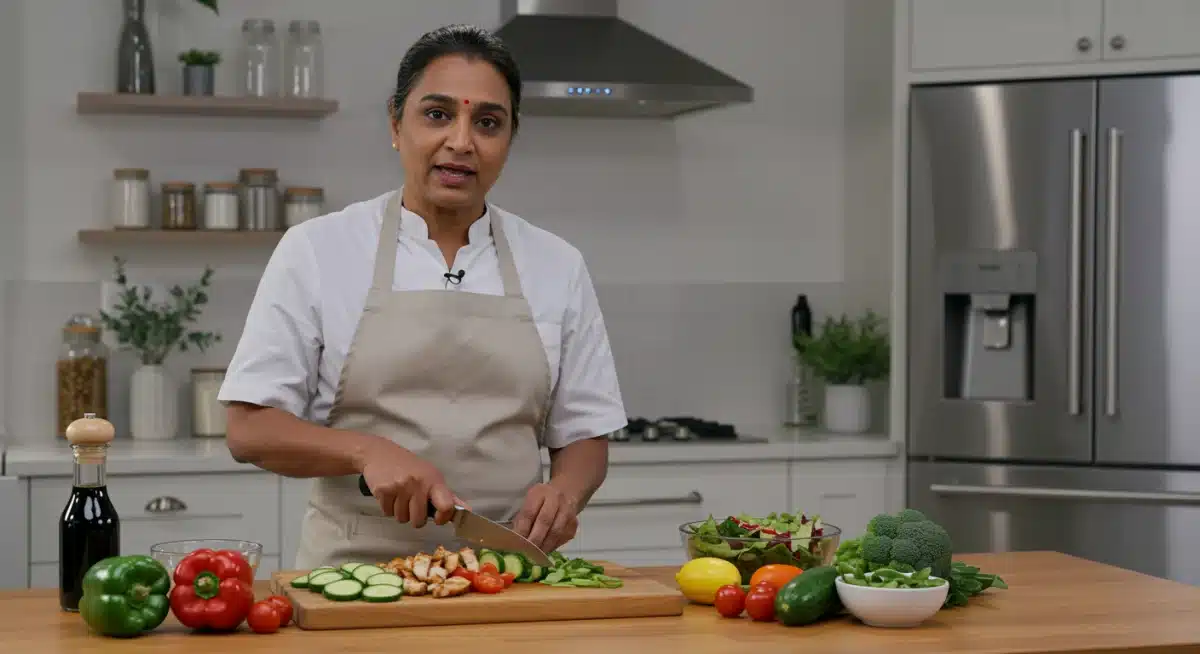
By planning ahead, you can enjoy the full spectrum of summer flavors and nutritional benefits without feeling overwhelmed. This systematic approach transforms healthy eating from a chore into an effortless and delicious part of your summer routine.
Sustainable Practices for Summer 2025
Adopting seasonal eating summer 2025 naturally aligns with sustainable living. Beyond the direct benefits of consuming fresh, local produce, there are broader practices that can amplify your positive impact on the environment. These practices range from reducing food waste to supporting farming methods that protect our planet’s resources.
Sustainability in food consumption is about making conscious choices that consider the long-term health of the environment and future generations. It involves understanding the journey of our food from farm to table and seeking ways to minimize negative ecological footprints. Every small step taken towards more sustainable eating contributes to a larger collective effort.
Reducing Food Waste
Food waste is a significant environmental concern, contributing to greenhouse gas emissions and squandering valuable resources. Seasonal eating, when combined with smart planning, can dramatically reduce waste. Utilize all parts of your produce, from vegetable scraps for broths to overripe fruit for smoothies or jams.
- Composting: Turn vegetable and fruit scraps into nutrient-rich soil for gardens.
- Creative Leftovers: Transform leftover cooked vegetables into frittatas, stir-fries, or soups.
- Proper Storage: Learn the best ways to store different types of produce to extend their freshness.
Supporting Local and Organic Farms
Choosing local and organic produce is a powerful way to support sustainable agriculture. Local farms often employ practices that are less resource-intensive and more environmentally friendly. Organic farming, in particular, avoids synthetic pesticides and fertilizers, promoting soil health and biodiversity.
By purchasing from these sources, you’re not only getting healthier food but also investing in a food system that prioritizes ecological balance and community well-being. Look for certifications or engage directly with farmers at markets to understand their growing methods. This direct engagement builds trust and encourages responsible consumption.
Ultimately, integrating sustainable practices into your seasonal eating habits is a testament to mindful living. It ensures that your pursuit of personal health also contributes to a healthier planet for everyone.
Overcoming Challenges in Seasonal Eating
While the concept of seasonal eating summer 2025 is appealing, practical challenges can sometimes arise. These might include limited availability of certain produce, higher costs for organic or locally sourced items, or simply the time commitment required for meal planning and preparation. Addressing these hurdles proactively can make the transition to seasonal eating smoother and more sustainable in the long run.
It’s important to remember that seasonal eating doesn’t have to be an all-or-nothing endeavor. Even small changes can make a significant difference. Flexibility and creativity are key to adapting to what’s available and making the most of your resources. Don’t let perceived obstacles deter you from enjoying the numerous benefits.
Budget-Friendly Seasonal Choices
Eating seasonally can actually be more cost-effective, especially when buying directly from farmers’ markets or when produce is in peak abundance. When fruits and vegetables are in season, the supply is higher, which often drives prices down. Look for sales and consider buying in bulk when items are at their cheapest.
- Buy in Bulk and Freeze: Purchase large quantities of seasonal berries or corn and freeze them for later use.
- Utilize Community Supported Agriculture (CSA): Join a CSA program to receive a weekly box of fresh, local, and often organic produce at a predictable cost.
- Cook from Scratch: Preparing meals at home using whole, seasonal ingredients is almost always cheaper than eating out or buying processed foods.
Time Management and Convenience
For those with busy schedules, the idea of cooking every meal from scratch can seem daunting. However, with a few strategic approaches, seasonal eating can be integrated even into the most hectic routines. The key lies in efficient meal planning and smart batch preparation.
Dedicate an hour or two on a weekend to wash, chop, and store vegetables, or to cook a large batch of grains. This front-loaded effort saves significant time during the week. Explore quick and easy recipes that require minimal cooking, such as large salads, wraps, or simple grilled dishes. Remember, convenience doesn’t always have to come at the expense of seasonality or health.
Facing these challenges head-on with practical strategies will empower you to fully embrace seasonal eating, transforming it into an enjoyable and integral part of your healthy Summer 2025 lifestyle.
| Key Aspect | Brief Description |
|---|---|
| Nutrient Density | Seasonal produce is richer in vitamins, minerals, and antioxidants due to natural ripening. |
| Flavor Profile | Peak season fruits and vegetables offer superior taste and aroma compared to out-of-season alternatives. |
| Sustainability | Supports local agriculture, reduces carbon footprint from transportation and packaging. |
| Cost-Effectiveness | Often more affordable due to higher supply and direct purchasing options like farmers’ markets. |
Frequently Asked Questions About Seasonal Eating in Summer 2025
Seasonal eating in Summer 2025 is vital because summer produce is at its peak ripeness, offering superior flavor and maximum nutrient density. It also supports local economies and reduces environmental impact by minimizing transportation needs for fresh foods.
For Summer 2025, focus on berries (strawberries, blueberries, raspberries), stone fruits (peaches, plums, nectarines), and various melons (watermelon, cantaloupe, honeydew). These fruits are abundant, delicious, and packed with essential vitamins and antioxidants.
To find local seasonal produce, visit your nearest farmers’ markets, join a Community Supported Agriculture (CSA) program, or check local farm stands. Many grocery stores also highlight locally sourced and in-season items during the summer months.
Yes, seasonal eating can be budget-friendly. Buying produce at its peak season often means lower prices. Look for sales, buy in bulk and freeze, or consider joining a CSA. Cooking from scratch with seasonal ingredients is generally more economical than processed foods.
To preserve nutrients, opt for gentle cooking methods like steaming, grilling, or light sautéing. Eating produce raw in salads is also highly beneficial. Avoid over-boiling, which can deplete water-soluble vitamins from delicate summer vegetables and fruits.
Conclusion
Embracing seasonal eating summer 2025 is more than a dietary choice; it’s a lifestyle enhancement that brings a multitude of benefits. From maximizing your nutrient intake and enjoying superior flavors to supporting local communities and promoting environmental sustainability, the advantages are clear. By consciously choosing what’s fresh and available, you contribute to your personal well-being and the health of the planet. Let this summer be a season of vibrant, healthy, and mindful eating, transforming your relationship with food for the better.

